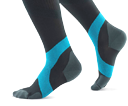| Compression Stockings for Air Travel8 October 2015 | John One of the biggest scares for people who often fly on long haul flights is the risk of developing deep vein thrombosis (DVT). There’s been a huge amount of debate surrounding the link between DVT and flying long haul, but the correlation can’t be ignored, especially if you’re a nervous flier. What is DVT?Deep vein thrombosis (DVT) is a condition where a vein deep in your body clots. It’s most common to form in your leg, usually a bigger vein which goes through your calf and thigh muscles. The symptoms of DVT can vary, and in some cases there can be no symptoms at all (which is what can make it so terrifying), but some possible symptoms are pain and swelling in your leg and red, warm skin on your leg. DVT can in some cases lead to a pulmonary embolism – the blood clot can come away from the vein in your leg and lodge itself in a lung, causing chest pain and breathlessness. Why Can DVT Develop During Air Travel?One of the risk factors for DVT is a long period of inactivity – like being sat in the same place for several hours. The risk of developing DVT on a long haul flight with no other risk factors is low, but it can happen. Other risk factors include a history of DVT, cancer, stroke, obesity and heart disease. It’s difficult to know the exact relationship between DVT and air travel because it can be symptomless and might not occur for a while after flying, so it's hard to get a solid reading on whether the cause was the flight or some other factor. However, the evidence is too high to ignore. How Can Compression Stockings for Air Travel Reduce the Risk of DVT?Compression stockings are designed to help increase circulation and blood flow in legs. They do this by stimulating the natural pumping action of the muscles in the legs, which increases the rate blood moves around your leg. This is usually used to treat more chronic conditions like varicose veins and lymphoedema, but light compression can help reduce the risk of developing DVT. Because compression stocking help increase circulation, it reduced the chance the blood has to stay in one place and clot. In fact, the NHS recommends wearing compression stockings for air travel if you're worried about DVT while flying. What Else Can I Do to Reduce the Risk of DVT While Flying?If you’re concerned about the risk of developing DVT while flying you should consult a doctor. They’ll be able to recommend what’s best for you, both in terms of compression stockings and other options like leg exercises you can do while on the plane. Interested in getting some compression stockings for air travel? Head on over to Compression Stockings and check out our range of Flight Socks. |







